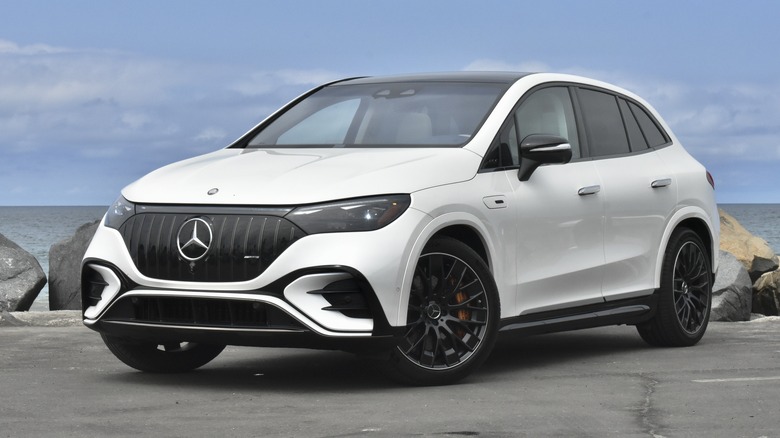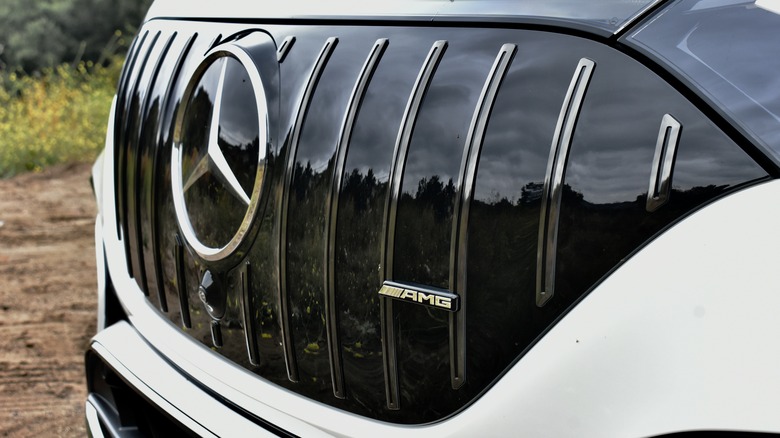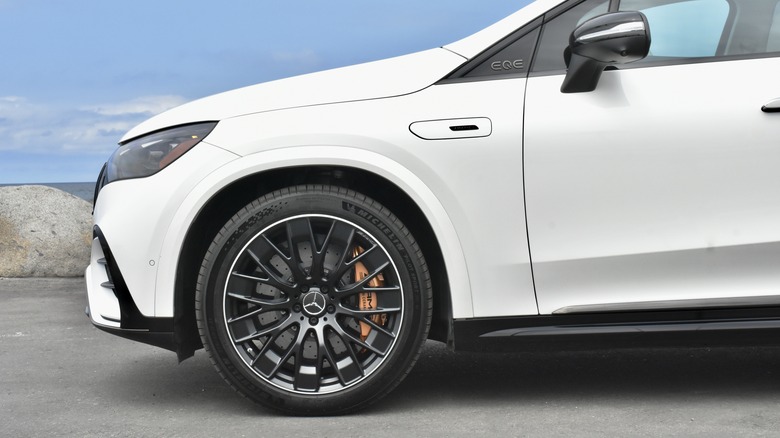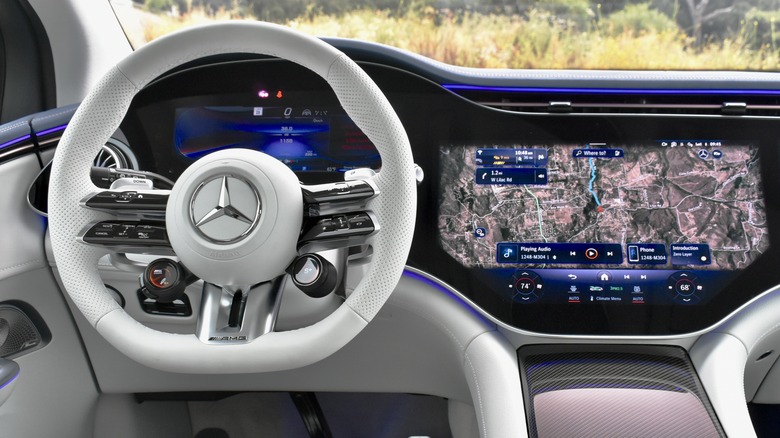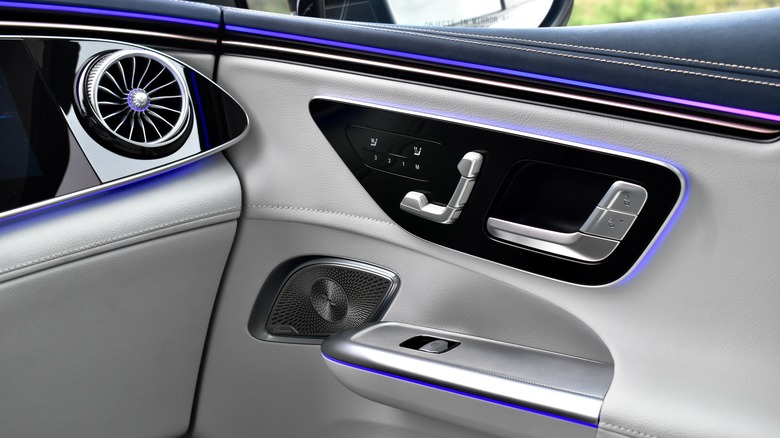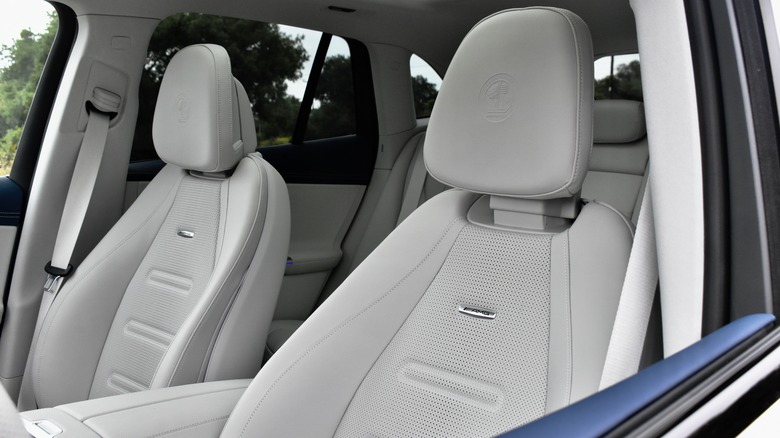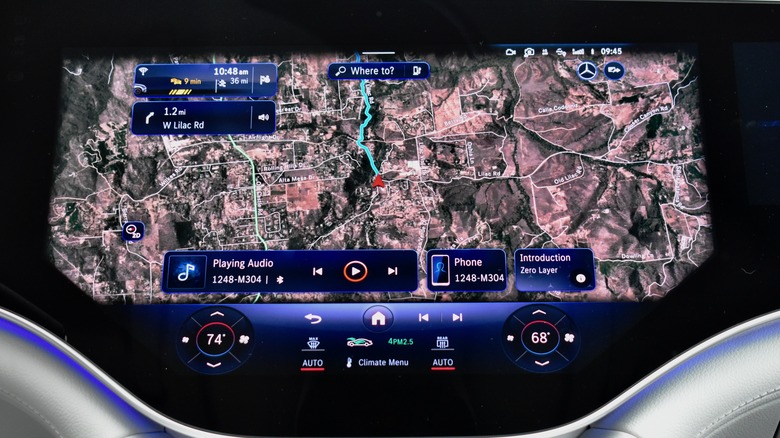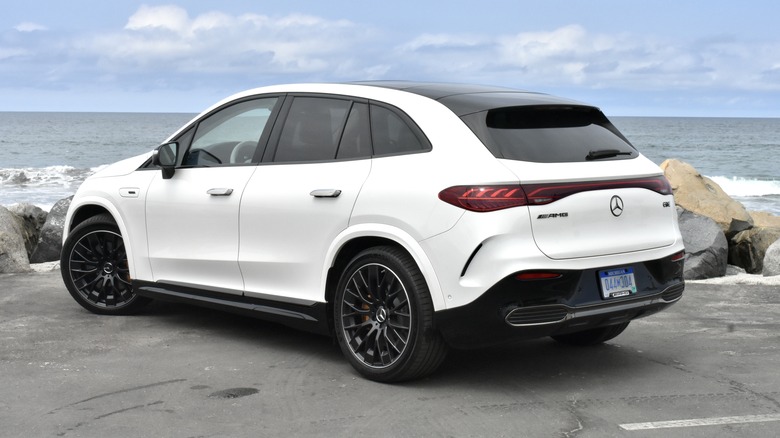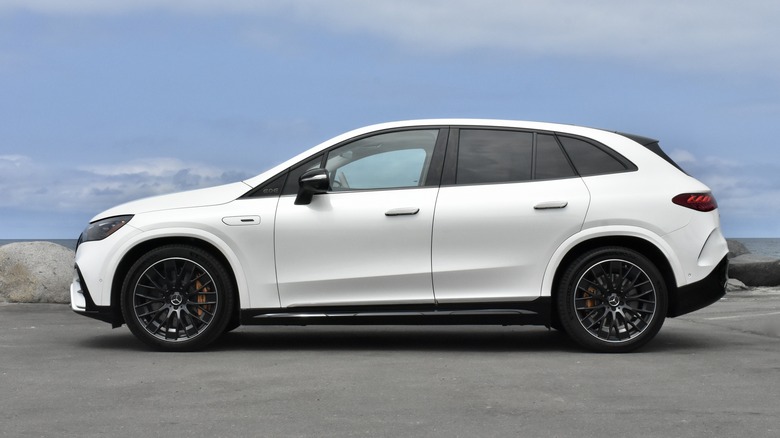2024 Mercedes-AMG EQE SUV First Drive: Fast Filling In The Gaps
It's getting hard to keep track of Mercedes' EQ electric cars, which means the venerable automaker must really be serious about electrification.
Mercedes has built up a sprawling lineup of internal-combustion cars and SUVs, with most models getting at least one AMG performance variant. Which brings us to the Mercedes-AMG EQE SUV. Its three-squared name denotes this as a performance version of the all-electric EQE SUV, the third AMG EQ model (following the EQE and EQS sedans), but the first crossover.
AMG imbued the EQE SUV with the upgrades we've come to expect from its internal-combustion work, including more power, a tauter chassis to control it, and subtle styling changes. This brings Mercedes a step closer to offering an electric equivalent to each of its gasoline models, but is the AMG EQE SUV more than just a place-filler?
Spot the difference
AMG models have traditionally hidden their extra performance behind plain wrapping, and that's still the case with the AMG EQE SUV. Only a few details distinguish this sportier variant from the standard EQE SUV.
Being electric, the EQE SUV doesn't have a grill as such. But the place where the grille would normally be has sprouted some vertical bars, as if the blacked-out area between the headlights was some kind of growth medium for chrome. Designers were looking for some continuity with gasoline AMG models, which get functional grilles with similar-looking vertical bars.
Other than that, you'll need a standard EQE SUV for comparison to spot the AMG-specific front splitter and rear diffuser. Depending on the wheel design (AMG models get 21-inch or 22-inch wheels, sizes optional on the base EQE SUV), the gold AMG brake calipers may show through, doing a much better job of telling what this car is all about than the slightly reshaped bodywork.
The basic body shape itself was designed to minimize aerodynamic drag, always important in an EV for maximizing range. Mercedes didn't say whether the AMG changes lowered the coefficient of drag from the impressive 0.25 of the standard EQE SUV, but either way the emphasis on aerodynamics doesn't yield the most attractive shape. In white, it looks like a lopsided dollop of whipped cream.
More power, as expected
The crucial performance improvements start with AMG-specific motors in the predictable dual-motor all-wheel drive setup. Together, the two motors produce 617 horsepower and 701 pound-feet of torque—increases of 215 hp and 68 lb-ft over the most powerful non-AMG EQE SUV—and a Race Start mode boosts that further to 677 hp and 738 lb-ft. Battery capacity is unchanged at 90.6 kilowatt-hours of usable capacity.
Using Race Start mode, the AMG EQE SUV will lurch from zero to 60 mph in 3.4 seconds, according to Mercedes, while the top speed is governed at 149 mph. Even without Race Start, which is essentially a stand-in for the launch control systems in internal combustion cars, acceleration felt appropriately ferocious. A few pulls away from stoplights and you'll be able to cancel your next chiropractor appointment.
Fighting weight with tech
The AMG EQE SUV is able to efficiently turn electrons into g-force, rather than tire smoke, because of all-wheel drive. Having one motor per axle allows for more flexibility in front/rear torque distribution than mechanical systems used in internal combustion cars, and AMG tuned this version to be a bit more lively—including the ability to send 100% of torque to the rear axle in certain (un-glimpsed on our test drive) situations.
AMG engineers also made changes to the chassis components that help the standard EQE SUV hide its considerable girth. Rear-axle steering, which can turn the rear wheels up to nine degrees, is standard, as is an air suspension system with AMG-specific wheel carriers, suspension links, and anti-roll bars for increased rigidity.
The AMG EQE SUV also features an electromechanical active roll stabilization system, which uses 48-volt electrical power and some actuators to couple and decouple the anti-roll bars. Uncoupling allows the wheels on a given axle to move independently, isolating bumps, while coupling them back together allows the anti-roll bars to perform as normal, reducing body roll and making the SUV corner flatter.
Competent but cold
The experience of putting all of this hardware to work is less than satisfying. On tight, twisty roads, this electric performance SUV's grip and composure are impressive, but nothing makes you want to push harder, or keep going any longer than necessary.
The problem is that this is still a heavy vehicle (5,930 pounds, according to the spec sheet) that relies on gadgetry to corner with urgency, and that's more apparent here than it is in, say, a Porsche Cayenne. The AMG EQE SUV never put a wheel wrong, or felt pushed beyond its limits, but it's a classic example of a performance vehicle that just isn't very engaging to drive.
Part of that may be down to the "SUV" part of the AMG EQE SUV. The high seating positioning means you feel a bit detached from the movement of the vehicle, like you're commanding a medium-sized warship from its bridge. It also makes it harder to judge where the car is in relation to the lane markings, which doesn't inspire confidence when threading this wide EV down narrow roads. And the steering felt like a video-game simulation, not something actually changing the direction of two rubber contact patches.
An EV that makes you want to skip regenerative braking
Creating feedback and character is one of the main challenges for performance EVs, but AMG was at least a bit more successful in tackling another.
When driving fast, the limiting factor isn't power, it's braking. EVs add a new layer of complexity in the form of regenerative braking which harvests excess energy to both slow the car and help charge the battery pack. But reigning in up to 677 hp also requires sturdy mechanical brakes, and the two braking technologies had to be made to play nicely.
AMG gave the EQE SUV the kind of brakes you'd expect to find on a traditional performance car. The fronts consist of six-piston calipers and 16.3-inch rotors, while the rears get single-piston calipers and 14.9-inch rotors (a carbon-ceramic system is also available). This lets you ignore the regenerative braking and stomp on the pedal like you would in any other AMG model, the brakes responding with predictable pedal feel and plenty of decelerative force.
But the blending of regenerative and mechanical braking is pretty good as well, providing the same consistent feel no matter when you choose to press the brake pedal. Unless you have the regenerative braking on its strongest setting, that is, in which case the pedal disconcertingly retreats from your foot. This behavior, common to all Mercedes EQ electric models, is meant to match the pedal's travel with the amount of regenerative braking. But it's not exactly confidence-inspiring.
Still a Mercedes on the inside
The AMG EQE SUV's biggest asset is that, regardless of how it drives, it's still a Mercedes on the inside. With its plush leather seats and elaborate audio system with Dolby Atmos tech, this is the automotive equivalent of lifting weights from a La-Z-Boy.
Mercedes' current interior design theme has been reproduced on a few different models at this point, but still looks fresh. The round air vents, flat surfaces for the screens, and curved door-panel trim framing them, do carry over from the standard EQE SUV, however, so owners will have to point out a sprinkling of AMG logos to show passengers that their car is special.
A functional touch is the pair of knobs on the steering wheel, which control drive modes, damper firmness, and other settings. It's much easier than using the tiny drive-mode button on the center console, or digging into touchscreen menus.
Speaking of touchscreens, the AMG model will be the only version of the EQE SUV sold in the U.S. to get the dashboard-spanning Hyperscreen setup. Aside from some AMG-specific graphics, the digital instrument cluster and central touchscreen are the same as in the non-AMG model, but here the front passenger also gets their own screen. The same setup is featured in the EQS SUV and sedan, and European-market EQE SUV models, and its usefulness has been questionable in all of them. Here the front passenger can at least access a virtual stopwatch, in the unlikely event an owner enters their electric Mercedes SUV in a time-trial rally.
Performance over efficiency
Mercedes hasn't released range ratings for any EQE SUV models, but considering that the more powerful AMG version uses the same battery pack as the rest of the lineup, you can expect lower range than its less-sporty siblings. Indicated energy consumption on a mostly-highway drive between Encinitas and Santa Monica, California, was just under 2.7 miles per kWh. That's not great, but not surprising in a nearly 6,000-pound SUV designed to be driven with a lead foot.
We didn't have a chance to test out charging performance, but the numbers suggest mere adequacy. Mercedes says the AMG EQE SUV will DC fast charge at up to 170 kilowatts and Level 2 AC charge at 9.6 kW, so it's well behind even a humble Hyundai Ioniq 5, which can fast charge at up to 350 kW thanks to an 800-volt electrical architecture.
Mercedes also hasn't released pricing information for the AMG EQE SUV, which is scheduled to reach U.S. showrooms later in the 2023 calendar year, but expect it to cost as much as a small fleet of Hyundais. The standard EQE SUV reaches $96,400 with destination in EQE 500 4Matic Pinnacle form, so the AMG version will likely cross into the six-figure range.
An electric SUV for Mercedes fans
AMG's upgrades have improved the EQE SUV, giving its giggle-inducing acceleration and more composed handling. So the performance division's first electric SUV is indeed a true AMG, enhancing the vehicle it's based on without compromise.
Whether that really matters to anyone other than diehard Mercedes fans is questionable, though. There are several fast, expensive EVs, albeit fewer SUVs, and the AMG EQE SUV doesn't distinguish itself. It isn't engaging to drive, and is unlikely to surpass Tesla or Lucid in key EV metrics like range, efficiency, or charging performance.
The AMG EQE SUV is indicative of the challenge Mercedes faces as it shifts toward an all-electric market, something the automaker aims to accomplish in at least some markets by the end of the decade. Before it can focus on taking on EV leaders, Mercedes needs to convince its existing customers to go electric. And the AMG EQE SUV makes a good sales pitch.
The standard EQE SUV has the luxurious feel of traditional Mercedes models, and the AMG version adds an extra dollop of performance on top of that. Customers looking to stay with Mercedes won't have to look elsewhere, and that's probably all the automaker's product planners wanted.
